UNIT MARKINGS OF 354TH COMBAT AIRCRAFT
I have developed 12 color profiles based on a publication by Walt Fink, Doug Gifford and Jim Pierce - International Plastic Modelers' Society Journal: The 354th Fighter Group in World War Two. Former 354th pilots and ground crew members were also consulted during group association reunions.
In late November 1943, new P-51B Mustangs with the Rolls-Royce Merlin engine began arriving at Boxted Air Station in standard USAAF ETO theater camouflage scheme of Olive Drab on the upper surfaces and Neutral Gray on the undersurface (See Figure 1 below). The 8th Ferry Service Command delivered the first five P-51 B's to the 354th Fighter Group on November 11, 1943 and by December 1st, the group had received 57 P-51's and flew its first operational fighter sweep with 24 planes over Knocke-St. Omer, near Calais, France.
By Spring 1944, American fighter units began to exhibit their own unit identities by applying bright color markings on their aircraft. The 354th Fighter Group was no exception, by D-Day combat aircraft were displaying brightly colored spinners and distinctive nose band designs on olive drab and natural metal finishes.
Index to Aircraft Color Profiles
Go directly to any aircraft profiles, click on any title below:
P-51B MUSTANG MARKINGS - LATE 1943 TO SPRING 1944
P-51D MUSTANG MARKINGS - SPRING 1944 TO NOVEMBER 1944
P-47D THUNDERBOLT MARKINGS - NOVEMBER 1944 TO FEBRUARY 1945
P-51D MUSTANG MARKINGS - FEBRUARY 1945 TO END OF HOSTILITIES
P-51B MUSTANG MARKINGS - LATE 1943 TO SPRING 1944
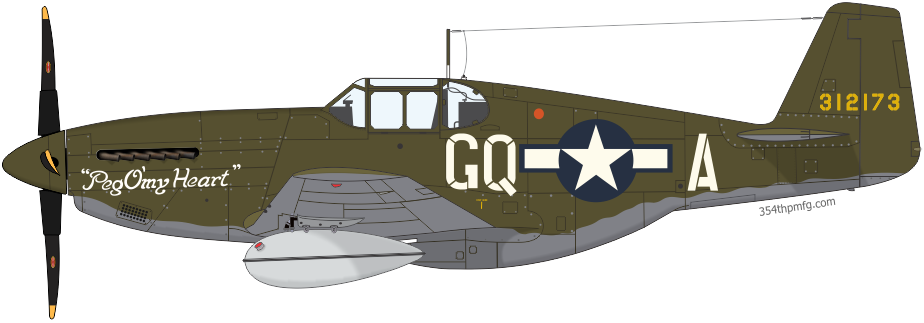
FIGURE 1
This North American P-51B-1-NA Mustang is in the standard European Theater camouflage finish, white squadron code letters and yellow painted serial numbers. "Peg O'my Heart" was assigned to Maj. George R. Bickell, Commanding Officer of the 355th Fighter Squadron, Boxted, December 1943.
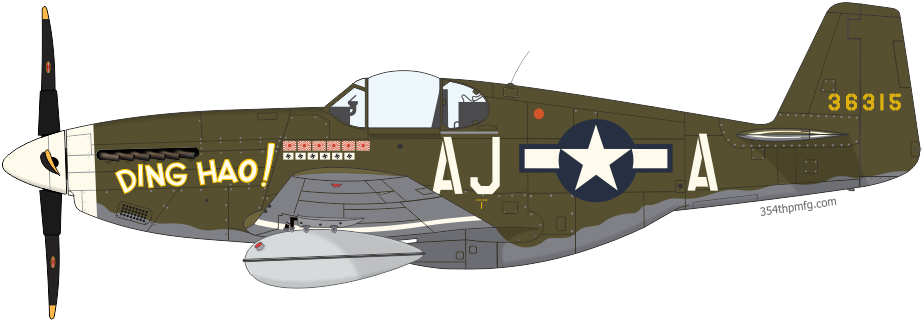
FIGURE 2
All Fighter Groups in the European Theater were ordered to paint their spinners white with a 12" white nose band and 12" bands on the upper/lower wing surface and elevator tailplane section to help bomber crews and other fighter pilots identify friendly fighters. The P-51B Mustang was often mistaken for a German ME-109. Mustangs of the 354th Fighter Group wore this color scheme up to when they began receiving natural metal finished aircraft. This P-51-5-NA Mustang "DING HAO!", fitted with a Malcon hood (a bulged Perpsex frameless canopy developed by R Malcolm & Co) was the personal mount of Lt. Col. James H. Howard, Commanding Officer of the 356th Fighter Squadron, Lashenden, April 1944. The Japanese kill markings are from his time with the Flying Tigers in 1941-42, officially destroying 2.333 in the air and four on the ground.
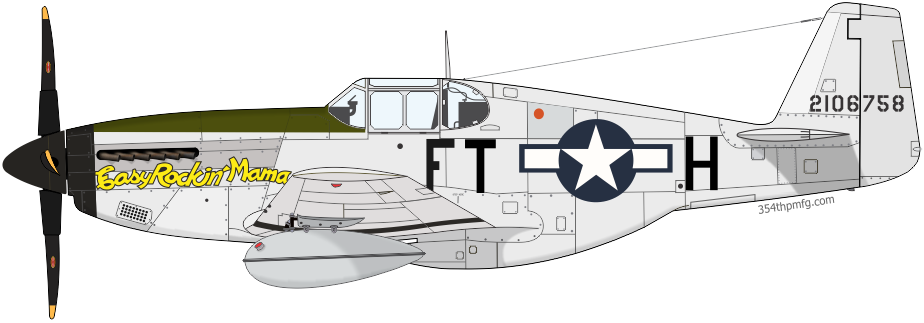
FIGURE 3
When natural metal finish Mustangs began arriving with 12" black nose bands from Air Service Depots, units applied black squadron code letters and black bands on upper/lower wing surface and elevator tailplane section. The top engine cowling panels were painted in olive drab to eliminate glare. This P-51B-15-NA Mustang "Easy Rockin' Mama", was assigned to Lt. James G. Burke, 353rd Fighter Squadron, Lashenden, May 1944.
P-51D MUSTANG MARKINGS - SPRING 1944 TO NOVEMBER 1944
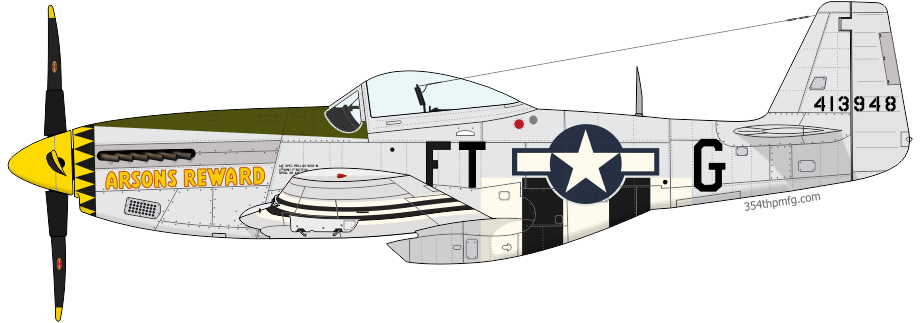
FIGURE 4 - 353RD FS
The definitive color scheme applied to 353rd Mustangs during this period on both olive drab and natural metal finish Mustangs was a yellow spinner with a wide yellow and black sawtooth nose band. Invasion strips were applied to all Allied aircraft for D-Day operations and would remain on aircraft through the rest of 1944. Other photographed color schemes used before the one shown above saw a black spinner with a wide black nose band and another was a yellow spinner with wide black nose band. This P-51D-5-NA Mustang "Arsons Reward", was assigned to Maj. Wallace N. Emmer, Criqueville (A-2), France, August 1944.
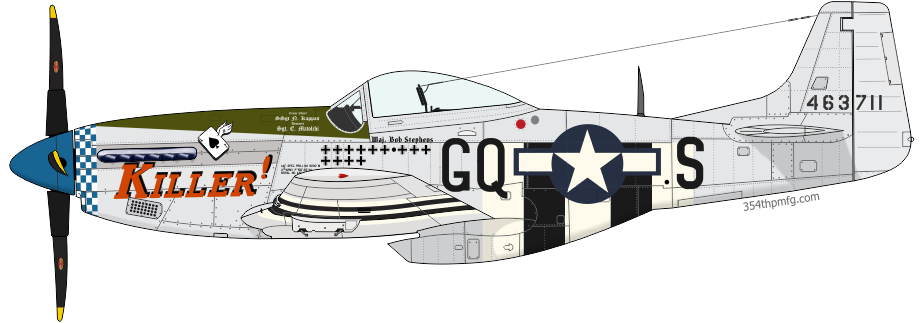
FIGURE 5 - 355TH FS
Mustangs of the 355th Fighter Squadron were painted with a blue spinner and wide blue and white checkerboard nose band on a natural metal finish with standard D-Day Invasion markings. Photographs also show Mustangs from this unit with the typical blue spinner, leading small blue nose band, followed by a blue and white diamond pattern on the engine cowling (Click the Reference Photos box below to view images). This P-51D-20-NA Mustang "KILLER!", was the mount of Maj. Robert W. Stephens, Commanding Officer of the 355th Fighter Squadron, Gael (A-31), France, August 1944.
-
355th Reference Photos
+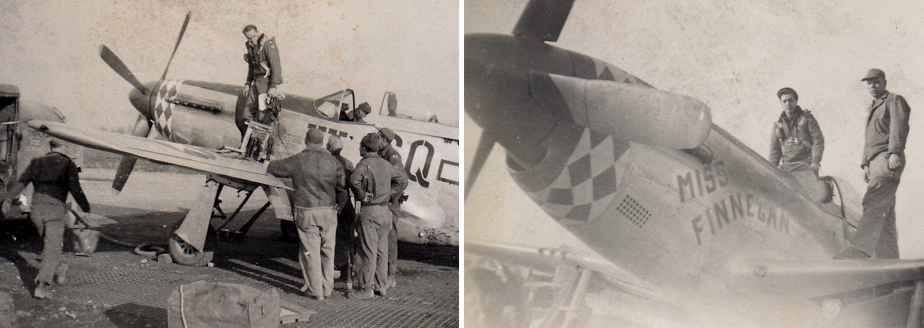
These photographs show the blue and white diamond pattern on 355th Mustangs. These markings would also appear on their P-47 Thunderbolts.
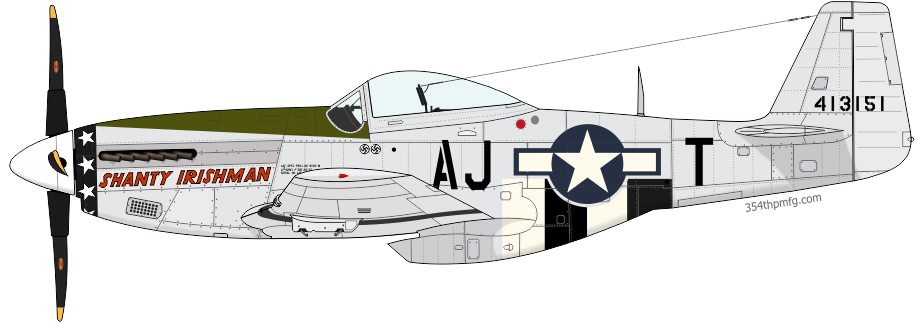
FIGURE 6 - 356TH FS
Mustangs of the 356th FS sported a white spinner with white stars on a wide black nose band on a natural metal finish. Note: Sgt. William W. Louie, the artist responsible for a significant number of the nose art on 356th aircraft stated that they began receiving natural metal finish Mustangs with existing black nose bands. It was Maj. Richard E. Turner, CO., who devised the design that would be used to identify the unit and so instructed S/Sgt. Mark Hanson and Sgt. Louie to paint a ring of white stars on the black band. The design would also be applied to P-47s in late 1944 (See Figure 9). This P-51D-20-NT Mustang "SHANTY IRISHMAN", was assigned to Capt. Franics P. McIntire, Jr., Gael (A-31), France, September 1944.
P-47D THUNDERBOLT MARKINGS - NOVEMBER 1944 TO FEBRUARY 1945
On November 13, 1944 the Pioneer Mustang Group received word that they would have to transition from Mustangs to Republic P-47 Thunderbolts. The P-47s coming in were a mixture of bubble-top and razorback models.
It was at A-98 Rosières-en-Haye that the Group would begin using their "Thunderbuckets" as they became known on dive-bombing, strafing and supporting troops on the ground but that did not deter 354th pilots from aerial engagements against the Luftwaffe.
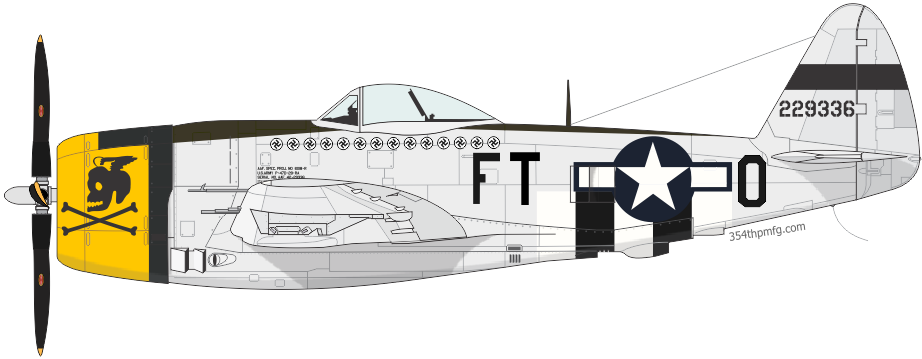
FIGURE 7 - 353RD FS
All yellow cowling with black cowl flaps and black winged skull and crossbones. This would became one of the most memorable designs on a Thunderbolt. This P-47D-28 Thunderbolt was assigned to Capt. Kenneth H. Dahlberg, 353rd Fighter Squadron, Rosières-en-Haye (A-98), France, December 1944.
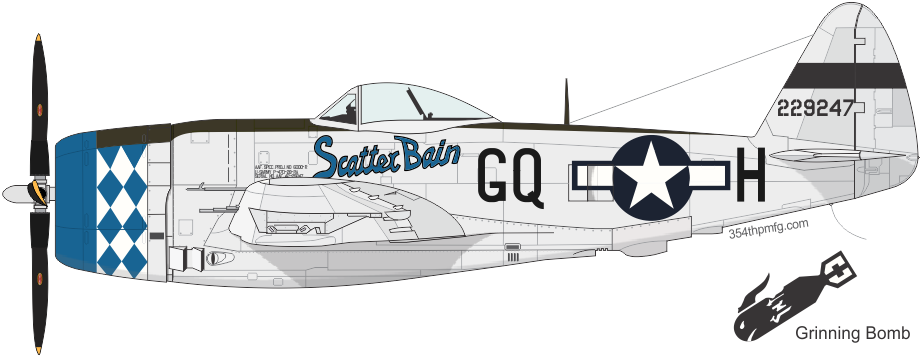
FIGURE 8 - 355TH FS
Leading blue nose band followed by a blue and white diamond pattern on the engine cowling identifies this Thunderbolt from the 355th Fighter Squadron. Some Thunderbolts painted a grinning bomb (see art work above) on the engine cowling. This P-47D-26 Thunderbolt named "Scatter Bain", was the personal mount of 1st Lt. Raymond P. Bain, 355th Fighter Squadron, Rosières-en-Haye (A-98), France, February 1945. 1st Lt. George J. New and P-47 were lost in action on 10 February 1945. Lt. Bain's replacement aircraft was a brand new P-51D-20 Mustang, coded GQ-S (S/N: 44-63193) also named "Scatter Bain". On 21 February, Lt. Bain flying his new Mustang was hit by flak while pulling off the target. Trailing long vapor and a smoke trail his Mustang caught fire. He was forced to bail-out near the German town of Neustadt, becoming a POW. During a 354th group association reunion, he told me how upset he was losing his new Mustang. "The painted 'Scatter Bain' hadn't even had a chance to completely dry".
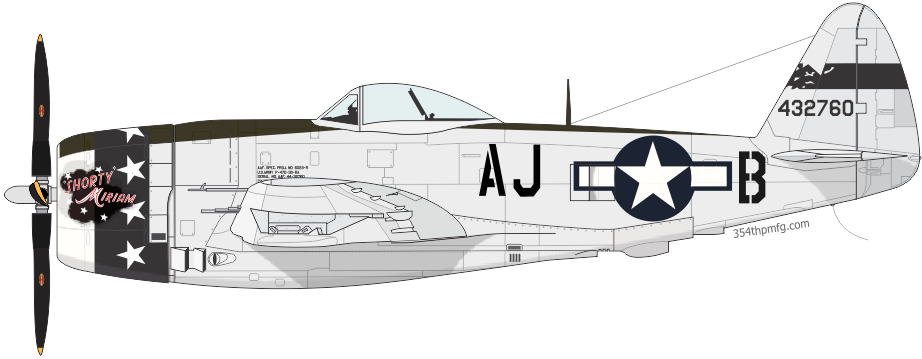
FIGURE 9 - 356TH FS
The 356th Fighter Squadron applied the same design as they had on their Mustangs, white stars on a black cowling band and white nose band. This P-47D-30 Thunderbolt "Shorty Miriam", was assigned to Lt. Norman E. Davis, 356th Fighter Squadron, Rosières-en-Haye (A-98), France, December 1944.
P-51D MUSTANG MARKINGS - FEBRUARY 1945 TO END OF HOSTILITIES
In mid February a welcome sight appeared over the base, Mustangs! The Group celebrated their return and in a few days were back to flying missions in their beloved Mustangs.
Identifying colors placed on their Mustangs were very reserved and uniform and would remain that way through to the end of hostilities in Europe.
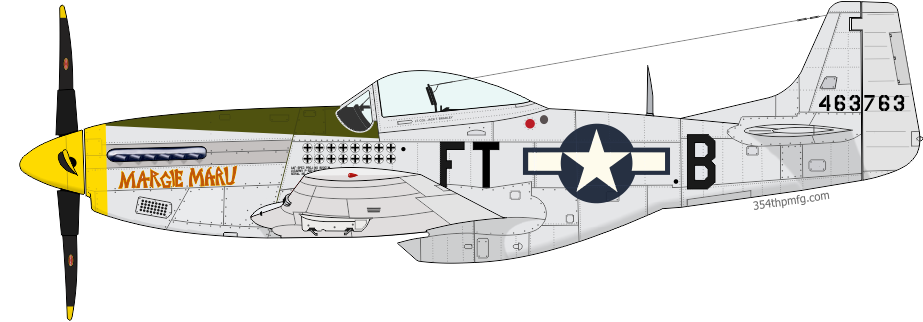
FIGURE 10 - 353RD FS
Yellow spinner with wide solid yellow nose band on a natural metal finish. This P-51D-20-NA Mustang "MARGIE MARU" in 353rd Fighter Squadron colors, was assigned to Lt Col. Jack T. Bradly, Deputy Commanding Officer, 354th Fighter Group Head Quarters, Rosières-en-Haye (A-98), France, April 1945.
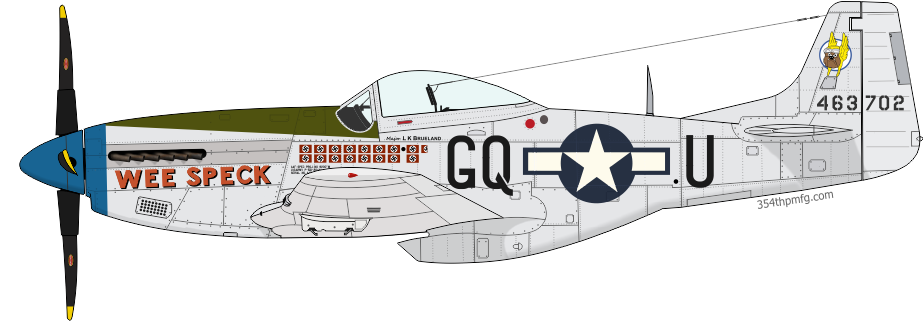
FIGURE 11 - 355TH FS
Blue spinner and wide solid blue nose band on a natural metal finish. Some 355th Mustangs had the "Pugnacious Pup" emblem painted on the vertical tail. This P-51D-20-NA Mustang "Wee Speck", was assigned to Maj. Lowell K. Brueland, 355th Fighter Squadron, Ansbach (R-45), Germany, May 1945.
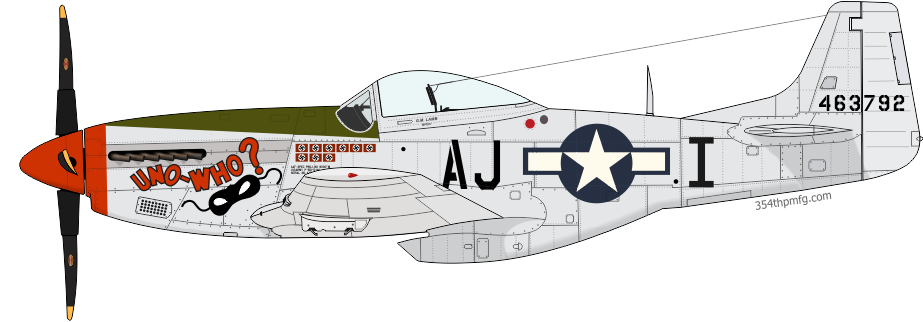
FIGURE 12 - 356TH FS
Red spinner with wide solid red nose band on a natural metal finish. This P-51D-5-NA Mustang named "Uno-Who?", was assigned to Maj. George M. Lamb, Rosières-en-Haye (A-98), France, March 1945.
